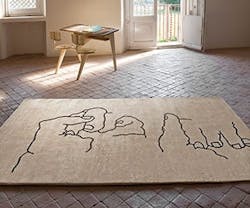The family of the late Spanish sculptor and graphic artist Eduardo Chillida could have been content to let the beauty of his work stand as crafted by his hands—after all, Chillida’s work is known the world over and has been featured in international exhibitions for decades. Nothing else was needed to celebrate or cement his artistry.
In honoring him, however, his family believed that his work could be translated into another medium. They turned to Nani Marquina, an equally talented artist known for the beauty of her company’s rugs, to develop a new line of floor coverings based on his artwork.
Ignacio Chillida, the artist’s son, articulates the family’s vision for the project. “Our family and those who work at the Museo Chillida-Leku, the museum where my father’s work is featured, constantly seek ways that we can present his work on an even broader scale. Nani Marquina is known for her professionalism, and she and her company are important to the world of rug design. We believed that they were best equipped to bring my father’s work to the world in a new way.”
Ignacio and other members of the Chillida family were intimately involved in all phases of the development process and worked with Marquina to select the original works that would be transformed into rugs. Eduardo Chillida’s catalog encompasses both two- and three-dimensional pieces, making the selection process slow and time-consuming; remaining faithful to the requirements of the original designs served as a foundation for the collection’s development.
After three years of work, the collection was finally unveiled at Salone del Mobile in Milan earlier this year.
“We ultimately selected seven different works on paper that reflect the various techniques my father used,” says the younger Chillida. “The topics expressed in these works are relevant to his artistry, especially his line drawings of hands and his collages and gravitational elements.”
The seven rugs in the collection are based on works that were completed between 1948 and 1995, capturing the breadth and evolution of Chillida’s work, according to Marquina. “Figura Humana” (1948) is, as the name implies, a human figure. “Gravitación” provides two images in the collection (1993 and 1995) as does “Manos” (1995), from which two carpet designs originate. “Dibujo Tinta” (1957) and “Colage” (1996) round out the collection. The designs vary in size, and are available in special dimensions. PageBreak
“Working on this endeavor was inspiring since I have always admired Chillida’s work and had thought about the possibility of doing something with his work for many years,” Marquina says. “I was surprised when one of his daughters contacted me and warmly welcomed the opportunity to work with the family.”
Marquina also notes that after 25 years in the business, it is important to have continuous evolution as part of the creative process. “The reproduction of these works into a rug collection shows that our company can start new roads while keeping the same essence and sensitivity when editing carpets,” she explains. “Our goal was to get closer to art. Chillida’s work is admired around the world and this collection helps us to be more international.”
The international descriptor relates not only to the collection’s appeal but to its manufacturing. All of the rugs are handmade in India using traditional methods, and each rug takes about three months to make. (Visit our digital edition to see a video of the process in action.)
“One of four techniques is used to make each rug,” says Marquina. “Hand knotting, which allows for all types of complex designs, is a completely manual process with the resulting carpet being differentiated from others based on the way of knotting, as well as the type and thickness of the knots. Persian hand-knotted rugs are similar to hand-knotting but from another origin. Hand-woven sumak involves forming a thin braid knot by knot, which gives a distressed look with a high-quality result, and which involves a great amount of work and imagination on the part of the Indian weavers. Finally, a hand-tufted technique that allows for elaborate designs but not precise curved ones is used. In this process, a manual method is carried out with the aid of a pistol-like device that cuts wool and inserts it into a cotton-cloth base on which the pattern has been previously marked.”
All of the rugs in the collection feature New Zealand wool—some up to 100 percent—bringing yet another international element to the line. The use of the wool was based on the product’s beauty and strength. It is also appropriate for use in the techniques used to communicate the spirit of each work. Other components include hand-spun mohair and silk.
The Chillida collection showcases a family’s passion for the legacy entrusted to their care, and the commitment of Nani Marquina to bringing the designs of Eduardo Chillida to life in another format—one that features the same level of craftsmanship that he infused into his own work. The rugs in the collection are as much art as a floor covering, and will make a beautiful addition to any space.
Janet Wiens is a freelance writer based in Memphis, Tenn. She was formerly a marketing manager for HNTB and now works with industry clients to address their marketing and public relations needs. She can be reached at [email protected].
